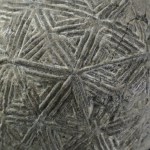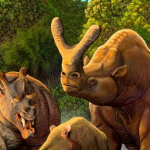Palaeontology
A little archaeological conundrum found its solution this morning. At an excavation in Motala in the early 00s, colleagues of mine found a cupped piece of hard, greyish brown material with a distinctly patterned inside. They interpreted it as a piece of a lost-wax casting mould and suggested in a 2004 publication that it was for a Viking Period tortoise brooch. I've never seen the find live, but I could tell from the pictures that the pattern was certainly not from the Viking Period. I wrote in my 2011 book about the area (p. 119), “the object in question has a shape and a geometrical…
You all know Don Prothero. He is an active member of the Skeptics and Science Blogging community. He is the author of several books, one of which you are totally supposed to own and if you don't it's kinda lame: Evolution: What the Fossils Say and Why It Matters. It occurred to me today that I never produced a formal review of one of Don's other books that I really enjoyed: Greenhouse of the Dinosaurs: Evolution, Extinction, and the Future of Our Planet. The reason for my skipping that review is that I had a radio interview with Don during which we discussed the topic as some length.…
Skull of Hadrocodium wui. (Image courtesy of Mark Klinger and Zhe-Xi Luo, Carnegie Museum of Natural History)
THE question of how mammals evolved their exceptionally large brains has intrigued researchers for years, and although many ideas have been put forward, none has provided a clear answer. Now a team of palaeontologists suggests that the mammalian brain evolved in three distinct stages, the first of which was driven by an improvement in the sense of smell. Their evidence, published in tomorrow's issue of Science, comes from two fossilized skulls, each measuring little more than 1cm in…
The Triassic is old. This book is new. That is a hard to beat combination.
Let's see ... The Triassic is about here:
(You can also look it up in this PDF file supplied by the USGS.
It is situated between two major extinction events, and is especially interesting because it is during this period that modern day ecological systems and major animal groups took a recognizable form. The preceding Permian, if contrasted with modern day, would form a very stark contrast while the Triassic would be at least somewhat more recognizable.
But of course the Triassic was in many ways distinct,…
Not Exactly Pocket Science is a set of shorter write-ups on new stories with links to more detailed takes by the world's best journalists and bloggers. It is meant to complement the usual fare of detailed pieces that are typical for this blog.
The rewarding side of being a psychopath
What goes on in the brains of psychopaths? They can seem outwardly normal and even charming, but tthese people typically show a lack of empathy, immoral behaviour and an impulsive streak. Joshua Buckholtz found that the last of these traits - impulsivity - may stem from a hyperactive reward system in the…
Even extinction and the passing of millennia are no barriers to clever geneticists. In the past few years, scientists have managed to sequence the complete genome of a prehistoric human and produced "first drafts" of the mammoth and Neanderthal genomes. More controversially, some groups have even recovered DNA from dinosaurs. Now, a variety of extinct birds join the ancient DNA club including the largest that ever lived - Aepyornis, the elephant bird.
In a first for palaeontology, Charlotte Oskam from Murdoch University, Perth, extracted DNA from 18 fossil eggshells, either directly…
The Not Exactly Pocket Science experiment continues after the vast majority of people who commented liked the pilot post. I'm really enjoying this, for quite unexpected reasons. It's forcing me to flex writing muscles that usually don't get much of a workout. Writing short pieces means being far more economical with language and detail than usual. It means packing in as much information as possible while still keeping things readable. And it means blitz-reading papers and writing quickly without losing any accuracy.
One quick note before the good stuff: last time, a few people suggested that…
Hold your arms out with your palm oriented vertically, as if you were trying to shake someone's hand. Now without moving your forearm, bend your hand downwards towards the floor. Unless you are freakishly flexible, you will only have managed to a measly acute angle. But if you were a bird, you could bend your wrist so that your hand pointed back towards your body. These incredibly flexible wrists allow birds to fold their wings and they help with flying. And many dinosaurs could do something similar.
Many older depictions of small raptors, including the Jurassic Park films, have them…
Not Exactly Pocket Science - panic aboard the Titanic, the rise of polar bears and emasculated frogs
I'm trying something new. Right from the start, I've always tried to write fairly long and detailed write-ups of new papers but this means that on any given week, there are always more stories than time and my desktop gets littered with PDFs awaiting interpretation.
So, I'm going to start doing shorter write-ups of papers that don't make the cut, linking to more detailed treatments on other quality news sources. This is something that I hope science journalists will do more of. It stems from a Twitter conversation where I asked if I should (a) write up short versions of these stories, (b)…
Snakes have been around for nearly 100 million years and scientists have found many fossils of extinct species. But this astonishing specimen is different. This serpent is Sanajeh indicus. It is sitting in a dinosaur nest and its coils surround three eggs and the body of a hatchling.
There are many reasons to think that this prehistoric tableau represented a predator caught in the act of hunting, rather than a mash-up of unconnected players thrown together by chance. The snake is perfectly posed, with its head resting atop a coil and its body encircling a crushed egg. All the pieces are…
National Geographic should have a 3-D animation up soon
The pursuit of accurate dinosaur colours just turned into a race, and a heated one at that. Just last week, I wrote about a group of scientists who claimed to have accurately identified the colours of some feathered dinosaurs by microscopically analysing three fossils. According to that study, Sinosauropteryx had a tail covered in ginger stripes. Now, another group have revealed the palette of an entire dinosaur, Anchiornis. This tiny predator had a dark grey body and the limbs bore long, white feathers tipped with black spangles. Its…
Dinosaur books have become more colourful affairs of late, with the dull greens, browns and greys of yesteryear replaced by vivid hues, stripes and patterns. This has largely been a question of artistic licence. While fossils may constrain an artist's hand in terms of size and shape, they haven't provided any information about colour. But that is starting to change.
The fossils of some small meat-eating dinosaurs were covered in filaments that are widely thought to be the precursors of feathers. And among these filaments, a team of Chinese and British scientists have found the distinctive…
Around 395 million years ago, a group of four-legged animals strode across a Polish coast. These large, amphibious creatures were among the first invaders of the land, the first animals with true legs that could walk across solid ground. With sprawling gaits and tails held high, they took pioneering footsteps. Their tracks eventually fossilised and their recent discovery yields a big surprise that could rewrite what we know about the invasion of land. These animals were walking around 18 million years earlier than expected.
The evolution of four-legged creatures - tetrapods - is one of…
It's a dinosaur tooth, and clearly one that belonged to a predator - sharp and backwards-pointing. But this particularly tooth, belonging to a small raptor called Sinornithosaurus, has a special feature that's courting a lot controversy. It has a thin groove running down its length, from the root to the very tip. According to a new paper from Enpu Gong of the Chinese Academy of Sciences, it was a channel for venom.
Thanks to a certain film that shall remain nameless, a lot of people probably think that we already know that some dinosaurs are venomous. But the idea that Dilophosaurus was…
This is Round Two of the NERS Stories of the Year Reader's Poll. To reiterate, or for those of you who've joined us late, I am going to select the most interesting stories from this blog over the last year by getting people to vote across a series of nine polls. Each will focus on a different theme and the last one will round-up missed stories and late-comers.
The animal behaviour poll is still going strong and this one will look at palaeontology. Here's your selection:
Breaking the Link - Darwinius revealed as ancestor of nothing
Raptorex shows that T.rex body plan evolved at 100th…
Around 15,000 years ago, North American was home to a wide menagerie of giant mammals - mammoths and mastodons, giant ground sloths, camels, short-faced bears, American lions, dire wolves, and more. But by 10,000 years ago, these "megafauna" had been wiped out. Thirty-four entire genera went extinct, including every species that weighed over a tonne, leaving the bison as the continent's largest animal.
In trying to explain these extinctions, the scientific prosecution has examined suspects including early human hunters, climate change and even a meteor strike. But cracking the case has…
The question of whether dinosaurs were warm-blooded or cold-blooded is one of the most enduring in palaeontology. Did they generate their own body heat like today's mammals; was their temperature more influenced by their environment like today's reptiles; or did they use a mixture of both strategies? Scientists have put forward a slew of arguments for all of these alternatives, but Herman Pontzer from Washington University has a new take on things which suggests that many dinosaurs were indeed warm-blooded.
Based on our knowledge of living animals, Pontzer worked out the energy that 14…
Cast your mind back to June, when a stunning fossil animal called Darwinius (alternatively Ida or "The Link") was unveiled to the world to tremendous pomp and circumstance. Hyperbolic ads declared the day of Ida's discovery as the most important for 47 million years. A press release promised that she would "change everything", headlines proclaimed her a "missing link in evolution" and the scientists behind the discovery billed her as "the closest thing we can get to a direct ancestor".
And according to a new study, none of that is true. Mere months later, Erik Seiffert from Stony Brook…
At 13 metres in length, Tyrannosaurus rex had little to fear from other predators. But it was occasionally attacked by an enemy far smaller than itself. In a wonderful piece of forensic palaeontology, Ewan Wolff from the University of Wisconsin has shown that the tyrant lizard king was often infected by a microscopic parasite, whose relatives still infect the birds of today. Potentially transmitted through bites from other tyrannosaurs, the parasite could have starved the infected animals to death.
Many of the large meat-eating dinosaurs have wounds on their heads that were clearly inflicted…
This article is reposted from the old Wordpress incarnation of Not Exactly Rocket Science. The blog is on holiday until the start of October, when I'll return with fresh material.
The sabre-toothed cat is one of the most famous prehistoric animals and there is no question that it was a formidable predator, capable of bringing down large prey like giant bison, horses, and possibly even mammoths. The two massive canines - the largest teeth of any mammal - are a powerful visual. But while they were clearly powerful weapons, scientists have debated their use for over 150 years.
Now, a new study…

